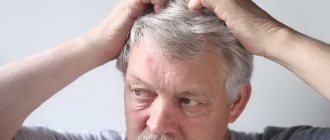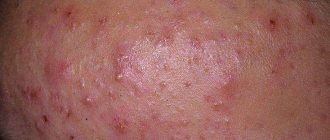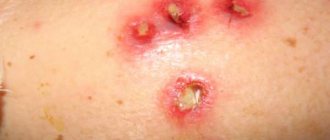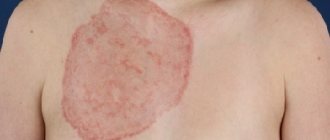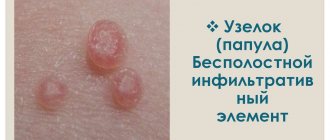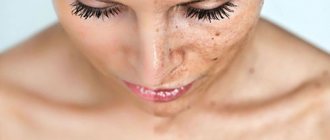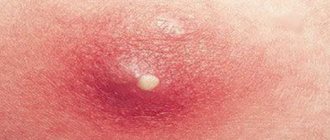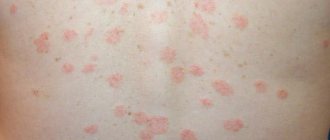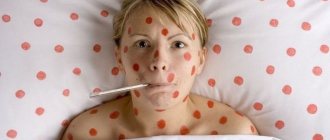Mechanism and causes of appearance
The skin takes part in the production of male sex hormones. In it, androgen precursors are converted into testosterone and dihydrotestosterone. Under the influence of these substances, skin cells grow and fat secretion occurs. Hormonal acne occurs against the background of high levels of androgens. The appearance of acne in this case is explained by the following reasons:
- on the surface of the skin, due to excess sebum, the amount of linoleic acid sharply decreases, this leads to irritation of the epidermis and the occurrence of an inflammatory process;
- with hypersecretion of the sebaceous glands, the viscosity of sebum increases, which leads to blockage of the glandular ducts and disruption of the functions of the sebaceous glands;
- sebum substances decompose under the influence of external factors and cause the appearance of various types of acne;
- Oily skin creates a favorable environment for the development of pathogenic bacteria that cause inflammation.
The starting point for the occurrence of hormonal acne is an excessive amount of male sex hormones . Increased androgen levels are associated with:
- Heredity. If both parents had severe skin rashes during puberty, there is a high probability that the child will develop such a problem.
- Uterine cycle in women. The last phase is characterized by an increase in the overall level of sex hormones. 70% of women develop skin rashes for this reason.
- Lipid metabolism disorders. There is an increased content of phospholipids, cholesterol, triglycerides, and other organic substances of this class in the blood. Their excess negatively affects blood circulation and causes pathologies. Disturbances in metabolic processes are caused by hormonal imbalances - for example, during menopause, as a result of taking contraceptives, corticoids, anabolic steroids and other hormonal pharmaceuticals.
- Pathologies of the endocrine system. Hormonal acne in women and men appears as a result of dysfunction of the adrenal glands and pituitary gland.
- Gynecological diseases. For example, polycystic ovary syndrome, abortion, pregnancy can cause excessive secretion of androgens in women (hyperandrogenism).
- Stress. Stressful situations and frequent long-term depression cause an increase in the concentration of steroid hormones.
- Improper skin care. It is necessary to determine your skin type and select appropriate cosmetics and procedures.
- Unfavorable climate. The body's reaction to increased air humidity and temperature is individual. These factors can cause pathological conditions of the skin.
What hormones cause acne to appear?
Hormonal acne is the result of disturbances in the functioning of the endocrine glands. The skin pores contain sebaceous glands that secrete oil. They contain androgen-sensitive receptors. Excessive concentration of male hormones in the body provokes increased secretion of fatty secretions. It provides a breeding ground for pathogenic bacteria. Therefore, overactive sebaceous glands increase the risk of inflammation of the hair follicles and the formation of acne.
Testosterone and DHEA-S
Testosterone and dehydroepiandrosterone sulfate (DHEA-S) affect receptors found in the sebaceous glands. They literally “force” them to produce more sebum. Increased testosterone in 98% of cases leads to dermatological problems. Its active form (dihydrotestosterone) begins to be produced by the adrenal glands even before puberty. Therefore, acne very often appears in teenagers.
If a woman has hormonal acne, she is prescribed hormone tests. If there is an increased concentration of androgens in the blood, a drug treatment regimen is drawn up. In addition, they follow a therapeutic diet, since the formation of dihydrotestosterone is influenced by diet and diet.
Excessive levels of testosterone in a woman’s body negatively affect the functioning of internal organs. Hormonal imbalance is accompanied by the formation of tumors on the ovaries, menstrual irregularities, seborrheic dermatitis, and hirsutism (male pattern hair growth).
Progesterone
The skin contains progesterone receptors that are sensitive to the steroid hormone. Progesterone is one of the main links in the synthesis of other steroid hormones and corticosteroids. Its deficiency leads to dysfunction of the sebaceous glands, thinning of the skin and the formation of wrinkles.
Despite the fact that progesterone is considered a pregnancy hormone, it can have a very direct effect on the condition of the skin, and that is why on certain days of the month acne, increased levels of oiliness in the epidermis and other unpleasant problems may appear on women’s faces.
Acne from hormonal imbalance occurs due to a chronic lack of progesterone. Its deficiency is fraught with serious disorders - polycystic ovary syndrome, neurological disorders. Typical signs of a lack of progesterone in the blood include:
- dull hair;
- the appearance of acne;
- menstrual irregularities;
- breast reduction;
- formation of dark spots in the groin;
- increased growth of facial hair.
If symptoms appear, you should consult a doctor - endocrinologist, gynecologist. Hormonal imbalances are fraught not only with acne, but also with more serious problems.
Estrogen
The sex hormones estrogen and progesterone are produced in women by the sex glands, that is, the ovaries. Acne on the face occurs when their functions are impaired and the level of steroid hormones in the blood decreases. Hormone-associated acne also occurs in women with hypothyroidism. A decrease in the activity of the thymus gland leads to a decrease in the amount of estrogen in the body.
Typical manifestations of hormonal imbalances include:
- ovarian pathologies;
- disruption of the menstrual cycle in women;
- dysmenorrhea;
- premature skin aging.
After ovulation, the concentration of estrogen in the blood decreases, which increases the influence of testosterone on the functioning of the exocrine glands. For this reason, 84% of women develop acne on the nose, chin, upper back, and chest a week before menstruation.
Other
The condition of the skin is directly affected by the content of other female and male hormones. Their level depends on the content of other bioactive substances that affect the activity of the adrenal glands, gonads, pituitary gland, thymus and pancreas. In 7% of cases, acne is the result of hyperandrogenism - an excess of androgens in the body.
In addition to natural causes, hormonal imbalance in the body can also be affected by various diseases of the endocrine system.
In 72% of patients, acne due to hormonal imbalance is caused by overactive pancreas. Excessive insulin production leads to fluctuations in blood sugar, which affects the functioning of the gonads. With a strong decrease in the amount of glucose in the body, the ovaries begin to synthesize more androgens.
Analyzes
An intense pathological rash may be accompanied by the appearance of pimple heads with pus, deep acne cysts, pain, itching and other signs of inflammation. To properly treat hormonal acne, it is necessary to conduct laboratory tests. All tests must be taken on a lean stomach; women donate blood for hormones at cycles 3, 7, 14 (on the recommendation of a gynecologist or endocrinologist).
A general blood test, a biochemical test for glucose levels, and a check for infection are preliminary laboratory tests. After this, you need to donate blood for hormones. The levels of testosterone, estrogens, cortisol, thyroid-stimulating hormone, T4 and others are checked.
Additionally, you may need an ultrasound of the endocrine glands, not only the reproductive glands (for example, ovaries), but also the adrenal glands, thyroid gland, and pituitary gland.
Hormone tests for acne are necessary to determine testosterone levels. The doctor will make a conclusion taking into account natural hormonal fluctuations. They happen:
- during puberty;
- during pregnancy, lactation;
- during the menstrual cycle;
- upon the onset of menopause.
If cosmetic procedures do not help get rid of acne, acne tests will help identify the root cause of the disease.
What tests should you take for acne?
Boils, acne are nonspecific symptoms that accompany perioral dermatitis, demodicosis, rosacea, etc. To identify the hormonal factor in the formation of acne, they undergo the necessary examination:
- Ultrasound of the ovaries and pelvis;
- MRI of the adrenal glands;
- Analysis of urine;
- blood chemistry;
- analysis of hormones (thymus gland, ovaries).
For multiple pimples on the face, the level of insulin in the blood plasma is determined, and the functional state of the liver is also assessed. Patients undergo consultation with a gynecologist, gastroenterologist, and endocrinologist.
In newborns
Even newborns have hormonal rashes. Rashes appear a few days after birth or the baby is already born with them.
The reasons that influence the manifestation of a pathological rash are associated with the high level of hormones in the mother’s body, which occurred during pregnancy.
The baby's sebaceous glands react to maternal hormones or the mother has acne-prone skin. Babies have few pimples; they look like lumps with slight redness around them. The rash in newborns appears on the forehead, nose, cheeks, nasolabial triangle, and back of the head.
This phenomenon does not require special treatment. It is enough to bathe the child on time, change bed and underwear. Normally, with regular hygiene procedures, the rash disappears after a few days.
How to treat hormonal rash?
Treatment of facial skin rashes includes the following measures:
- taking a blood test to check for excess hormones in the blood;
- maintaining a proper diet;
- normalization of daily routine;
- taking oral contraceptives by women containing estrogens and spironolactone, which reduces the concentration of androgens in the blood;
- taking Metformin and using Zinerit;
- the use of drugs containing magnesium, copper, calcium, zinc;
- consumption of probiotics to utilize excess hormones through the intestines;
- the use of face creams containing essential oils of rose hips, black currants or retinoids.
Treatment depending on the degree of rash
Taking into account the intensity of acne, therapy is carried out as follows:
- If there are no more than 10 pimples on the face, then the patient is diagnosed with mild acne. For treatment, local remedies are used in the form of ointments and creams.
- For moderate skin lesions due to hormonal rash, both local and internal preparations are used. The average form is considered to be about 30 rashes on the skin of the face.
- If the number of rashes is over 30, then a severe degree of hormonal rash is diagnosed. Treatment includes mandatory use of hormonal medications and antibacterial agents.
If the patient's rash is accompanied by extensive suppuration, then as part of therapy he is given subcutaneous injections of antibiotics and hormonal drugs. During treatment, it is also important to avoid sunlight and prevent drying of the skin.
Among women
Acne and hormones in women are interconnected conditions. The hormonal background changes several times during the month and depends on the phase of the cycle. Age-related changes in the body of women occur after 30. Ovarian function gradually begins to fade, and the amount of female hormones in the blood decreases, primarily estradiol.
Estrogens “restrain” the influence of androgens. But with a significant decrease in their concentration, testosterone provokes the occurrence of hormonal acne in women. As a rule, rashes appear on the skin of the face, back, and chest.
Hormonal drugs for women, in which progesterone predominates, also affect acne. Rashes may appear during treatment.
When choosing a drug for hormone replacement therapy, consultation with a gynecologist is mandatory.
After childbirth, there is a significant increase in the level of progesterone in a woman’s body; the amount of estrogen during this period is extremely unstable. As a result, the secretion of the sebaceous glands increases, the consistency of the fat changes and the ducts are blocked.
The rash appears on the neck and chin and lasts for several months. Taking hormonal contraceptives is effective, but when breastfeeding, only a doctor should select a medicine.
Features of hyperandrogenism
Hyperandrogenism, in other words, an excess of sex hormones, has pronounced symptoms. In addition to acne on the body, you can observe:
- Increased hair growth in women;
- Acne cannot be treated;
- Low timbre of voice in females;
- Rapid weight gain;
- Reducing breast size.
Less pronounced signs of hormonal imbalance may include severe fatigue, irritability, decreased libido in the fair sex, irregular periods, frequent headaches and pressure surges, and sweating. These signs are difficult to notice and link into one cause. We don't look at it as a symptom of a disease and then treat the dire consequences. To avoid this, listen to your body, give yourself time to rest and reboot.
In men
Hormonal acne in men is not always an indicator of high testosterone concentrations. Pathological acne occurs when taking large amounts of anabolic steroids. Or it may indicate insulin resistance and the presence of type 2 diabetes. Only in this case can we say that acne and hormones in men have a physiological connection.
As a rule, only in adolescence do hormonal changes provoke numerous acne on the back, on the face and in other places where sebaceous glands accumulate. Proper skin care and stabilization of the level of male hormones naturally improves the condition of the skin in young men.
Nutrition
When you talk to your doctor or dermatologist about the hormonal issues that are causing your acne, the first thing you will ask is how you can get rid of hormonal acne. This scheme is correct, because the doctor will first tell you how to solve the problem in the body, and only after that will explain how to treat acne.
Everything must happen in this order, because they are only symptoms. They often appear as a result of poor nutrition.
Frequent consumption of large quantities of very sweet, salty or spicy foods can disrupt the functioning of the gastrointestinal tract, which will immediately appear on your face.
Subcutaneous acne: causes of appearance and advice from cosmetologists on how to properly get rid of acne (115 photos and videos)How to remove acne - advice from dermatologists on complex treatment and an overview of the most common mistakes in diagnosis and removal (120 photos)
Acne remedy: how to find the right medicine for children and adults. Diagnosis and getting rid of acne at home (95 photos)
It’s not for nothing that our parents scared us that if we eat a lot of sweets, we’ll get pimples. The result of such a diet can be banal obesity, which is also included in the list of causes of acne.
Treatment for hormonal acne
Problems with acne caused by hormonal imbalance require consultation with several doctors: a dermatologist, an endocrinologist, and for women, a gynecologist. A comprehensive examination will help you find the most effective way to get rid of rashes. Therapeutic measures are carried out in several stages:
- Checking hormonal status.
- Taking prescribed hormonal and other medications (exfoliants, retinoids, benzoyl peroxide, azelaic acid, antibiotics, probiotics, vitamins).
- Treatment of acne from the outside using special cosmetics.
- Treatment of rashes with folk remedies.
- Professional facial cleansing (it is better to do this in a beauty salon to eliminate acne without traces).
- Organization of proper nutrition.
- Use of traditional medicine.
Treating acne with hormones is the most effective method. Doctors prescribe drugs with different effects:
- to decrease testosterone levels;
- contraceptives;
- increased concentration of estrogen;
- antiandrogens;
- elimination of insulin resistance.
Metformin reduces insulin resistance. After regular use of contraceptives with ethinyl estradiol and progesterone, androgen levels decrease. Antiandrogens reduce the secretion of testosterone and the formation of dihydrotestosterone.
Oral contraceptives are contraindicated for women with hypertension or high blood viscosity. Contraindications include malignant tumors in the mammary glands and smoking.
Factors that cause hormonal imbalance
Scientific studies have shown that hormone disruption occurs for certain reasons. There is no point in trying to find the cause of hormonal imbalance on your own. It is better to entrust this to a doctor. There are natural and acquired causes of hormonal imbalance. Most often, hormone failure occurs due to one’s own fault:
- Wrong lifestyle. Overwork at work, chronic lack of sleep and fatigue prevent a woman from recovering calmly. At such moments, in addition to acquiring depression, you are also at risk of hormonal imbalance.
- Unbalanced diet. Addiction to diets leads to the fact that the body does not receive the normal amounts of minerals and vitamins necessary for the synthesis of hormones. At the same time, overeating, indulgence in fatty foods, alcohol, and smoking slow down the normal processes of hormone production.
- Severe stress provokes the production of androgens. They turn on sebum production and start the chain of acne. Under stress, the body's protective and restorative functions are weakened, and acne appears again and again with full activity.
- Colds and venereal diseases (gonorrhea, syphilis) reduce the body's immunity and defenses, which leads to hormonal imbalance.
- Use of strong medications, steroids, and contraceptives. All medications must be strictly prescribed by a doctor. Acne due to hormonal imbalance from steroid use appears as nodular, cystic formations with cloudy contents. To treat such acne, it is enough to simply remove this drug from your lifestyle.
- Lack or excess of sex. It has long been established that when having sex, the body produces hormones that contribute to the normal state of human life. Hormonal levels and lovemaking are closely related, which is why acne formation is also present here.
Hormonal drugs
Properly selected hormonal acne pills give positive results after a few months. They are prescribed in courses, the dosage is determined by the doctor. This therapy helps cure acne due to hormonal imbalance.
In addition to oral medications, prescriptions may include hormonal ointment for acne. It improves metabolic processes in the skin and heals well. When prescribed and used correctly (taking into account contraindications), the ointment does not cause allergic reactions or other side effects.
When treating hormonal skin pathologies, she uses a special acne cream based on retinoids, azelaic acid. These substances are included in complex therapy in the treatment of hormonal acne. List of the most popular and effective means:
| Pills | Ointments | Creams |
| Jess | Hyoxysone | Baziron |
| Yarina | Triderm | Skinoderm |
| Dimea | Akriderm | Klenzit |
| Chloe | Akriderm | Different |
| Janine | Prednisolone | Kvotlan |
| Diana-35 | Hydrocortisone | Klindovit |
| Sinaflan | ||
| Elokom |
Before taking any hormonal medications, consultation with a doctor is required.
Reviews from women about home treatment
Hormonal acne in women can be treated not only with pharmaceutical drugs. If you study user feedback, instead of ointments and tablets, homemade lotions, masks and baths with medicinal herbs help a lot. To eliminate inflammatory lesions on the skin, the following is often used:
- agave;
- peppermint;
- calendula;
- chamomile;
- sage;
- oak bark
These plants have an antiseptic and decongestant effect and effectively relieve inflammation. At the same time, you need to understand that folk remedies will be effective only if the cause of the hormonal imbalance is eliminated. In addition, you need to take into account that you should not apply hot compresses to your face, since local heating of the skin can lead to the spread of the inflammation zone and deterioration of the condition of the epidermis.
Judging by the reviews, women often treat hormonal acne on their own, without rushing to see a doctor about this problem. Many people try to get rid of rashes using natural remedies. In particular, the following recipes are popular:
- With aloe. Add 2-3 drops of rosemary oil to the pulp obtained from the leaf of this plant. The resulting lotion is used to wipe the skin of the face throughout the day. The product cleanses well, so it can be used before applying medicinal ointments.
- Vegetable face mask. Cucumber, potatoes and pumpkin are grated and the resulting gruel is mixed in equal quantities. Then add 2 tbsp to the vegetable mix. l. sour cream and apply to the skin of the face, evenly distributing it over the surface and not affecting the skin around the eyes. Keep the mask on for 20 minutes, then rinse with warm water.
- Infusion of oak bark. For 1 liter of boiling water you will need 3 tbsp. l. vegetable raw materials. Use the resulting solution to wash or wipe the rash several times a day. Before use, filter the infusion through cheesecloth.
- Wormwood compress. An infusion of wormwood is prepared in the same way as the previous remedy with oak bark. A piece of natural fabric is soaked in the infusion, applied to the face and kept for 30-40 minutes.
Traditional recipes do not help everyone with hormonal acne, but according to reviews, most women notice an improvement after prolonged use. Before starting treatment with home remedies, you should make sure that there is no allergic reaction to the components used.
What diseases can be identified by the areas of the rash?
Hormonal acne, localized on certain parts of the face, indicates a malfunction of a particular organ. The location of the rash is projected onto the problematic organ.
Based on the location of acne on the face, one can judge the following problems:
- Forehead. Rashes in the center of the forehead indicate diseases of the small intestine and stomach. The zones on the sides indicate pathologies in the excretory system (bladder).
- Superciliary area. Pimples on it indicate heart problems.
- Temporal zone. Rashes on it indicate a malfunction of the gallbladder.
- Area around the eyes. Diseases of the kidneys, liver or spleen.
- Nose. Pimples on the nose indicate problems with the bronchi and pancreas.
- Cheeks. Rashes in the central part indicate stomach diseases, pimples in the cheekbones indicate problems with the respiratory system.
- Area around the mouth. Malfunction of the large intestine.
- Chin. Diseases of the reproductive system and thyroid gland.
See how to get rid of inflamed acne. How to treat purulent acne? Find out further.
Why do purulent acne appear in men?
The answer is here. Hormonal rashes on the face have various forms and can occur as a result of both external and internal factors. The main cause of the rash is the body's excessive production of male hormones.
The nature of treatment depends on the intensity of the rash on the face, as well as the results of blood tests for hormones.
